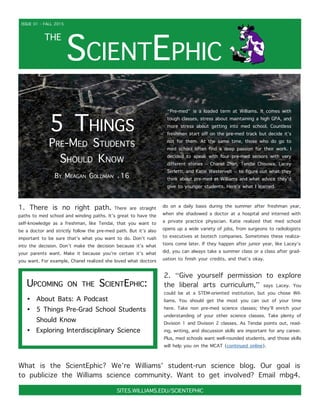
ScientEphic_Newsletter
- 1. ScientEphic THE ISSUE 01 - FALL 2015 SITES.WILLIAMS.EDU/SCIENTEPHIC 5 Things Pre-Med Students Should Know By Meagan Goldman ‘16 “Pre-med” is a loaded term at Williams. It comes with tough classes, stress about maintaining a high GPA, and more stress about getting into med school. Countless freshmen start off on the pre-med track but decide it’s not for them. At the same time, those who do go to med school often find a deep passion for their work. I decided to speak with four pre-med seniors with very different stories – Chanel Zhan, Tendai Chisowa, Lacey Serletti, and Katie Westervelt – to figure out what they think about pre-med at Williams and what advice they’d give to younger students. Here’s what I learned. 1. There is no right path. There are straight paths to med school and winding paths. It’s great to have the self-knowledge as a freshman, like Tendai, that you want to be a doctor and strictly follow the pre-med path. But it’s also important to be sure that’s what you want to do. Don’t rush into the decision. Don’t make the decision because it’s what your parents want. Make it because you’re certain it’s what you want. For example, Chanel realized she loved what doctors do on a daily basis during the summer after freshman year, when she shadowed a doctor at a hospital and interned with a private practice physician. Katie realized that med school opens up a wide variety of jobs, from surgeons to radiologists to executives at biotech companies. Sometimes these realiza- tions come later. If they happen after junior year, like Lacey’s did, you can always take a summer class or a class after grad- uation to finish your credits, and that’s okay. 2. “Give yourself permission to explore the liberal arts curriculum,” says Lacey. You could be at a STEM-oriented institution, but you chose Wil- liams. You should get the most you can out of your time here. Take non pre-med science classes; they’ll enrich your understanding of your other science classes. Take plenty of Division 1 and Division 2 classes. As Tendai points out, read- ing, writing, and discussion skills are important for any career. Plus, med schools want well-rounded students, and those skills will help you on the MCAT (continued online). Upcoming on the ScientEphic: • About Bats: A Podcast • 5 Things Pre-Grad School Students Should Know • Exploring Interdisciplinary Science What is the ScientEphic? We’re Williams’ student-run science blog. Our goal is to publicize the Williams science community. Want to get involved? Email mbg4.
- 2. sites.williams.edu/scientephic Nancy Piatczyc’s Microscopic World Science Faculty Weigh in on “Why Liberal Arts?” By Marcus Hughes ‘18 BMAC Builds Comunity Spirit By Elizabeth Jacobsen ‘16 When I told my friends at home that I was going to Williams College to study science, some of them asked me why I was choosing not to go to a STEM-oriented college. Their curiosity got me thinking. Why study science at a liberal arts institution? Why teach science at a liberal arts institution? What are the benefits of a liberal arts education for science students? To explore these questions, we decided to survey the Williams science faculty to find out why they teach at Williams and what they think about liberal arts. Many of the responses confirmed what we already know, while others highlighted the pros and cons of a Williams education specifically for science students. We generated word clouds with descriptive captions as a way of visualizing their responses (continued online). It’s an exciting time to be a biology major. This year the Biology Majors Advising Committee (BMAC) is redefining what it means to be a Biology major or prospective Biology major at Williams. BMAC hopes to build a unique sense of community among those interested in biology through an academic year of biology-related social events. BMAC is a group of eight junior and senior biology majors who work with both students and faculty to ensure students are getting the tools they need to be successful bi- ology majors. Their duties include direct advising of students considering the major, assisting with the hiring process for new professors, and organizing social events to build a sense of community. Many departments have advising committees with similar duties, but the collaborative nature of scientific work makes these especially strong in the science depart- ments. This year, BMAC is placing a special emphasis on building community through social events and enthusiasm. To help keep track of events, they have set up a Facebook group and have created a point reward system called BASH: Biolo- gy’s Awesome Scavenger Hunt (continued online). By Meagan Goldman ‘16 This article was inspired by the Art of Science, an initiative to gather and exhibit scientific images from students, faculty, and staff. For more information visit sites.williams.edu/artofscience. Right: Scanning electron micrograph of the hairs on a mullein leaf. “It’s endlessly fun looking at these things,” says Nancy Piatczyc while enlarging a black and white image on her computer. As the image focuses, striations appear. Without context, it might be difficult to identify what it shows: a tiny fragment of wood magnified thousands of times by a scan- ning electron microscope (SEM). The wood is from a sunken ship, likely British, that sank near the New York harbor around the time of the Revolutionary War. The SEM images will help biology professor Hank Art identify the wood from which the ship was built. Examining wood from a sunken ship is one of the many varied projects of Nancy Piatczyc’s job. As the Williams electron microscopy technician, Piatczyc lives in a world that is normally invisible to the human eye (continued online). SITES.WILLIAMS.EDU/SCIENTEPHIC
